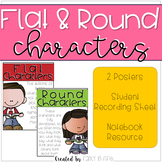

Consider the gray areas.Īnother way of examining how “round” a character is is by checking how many facets they have in their personality. Work on developing your character’s past by completing a character profile.

On the other hand, characters that you choose to leave “flat” don’t get that privilege. This means that you can make a character “round”-er by giving your reader a look into their past experiences. Develop a detailed backstory for them.Ī character’s backstory is part of what gives them depth. Readers want to know why the character would act that way, and these internal dialogues are what help readers relate to them. Give them strong motivations.Ī character’s motivation for wanting or doing something is often more important than the act itself. Some ways of ensuring you have round characters are: 1. The main characters almost always need to be round in order for readers to relate to them. This usually refers to characters that only have a quick or fleeting role, or even someone who is there all throughout the book, but does not serve any role that seriously affects the plot or the main character. In contrast, a flat character is one that is not as fully developed. Because these characters are more three-dimensional than others, it makes them more believable. They typically have clear quirks and motivations, and they’re the ones that get into conflict with one another. Round CharactersĪ round character refers to one that is developed in depth. They can serve supporting roles and help to advance the story without not taking attention from the main characters.

However, even the less-developed characters have a role to play in a story. That’s the power of creating characters with depth and dimension. When you read a novel or story, the best characters feel so real that it’s as if you know them in real life.


 0 kommentar(er)
0 kommentar(er)
